

This is a list of notable cherry dishes and foods that are prepared using cherries as a primary ingredient.


This is a list of notable cherry dishes and foods that are prepared using cherries as a primary ingredient.



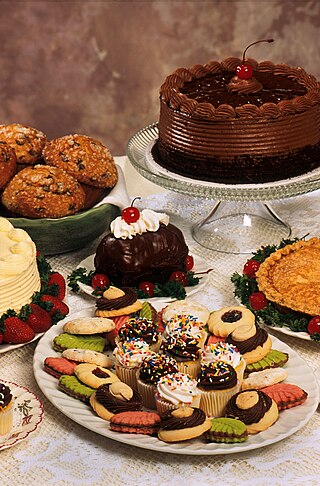
Dessert is a course that concludes a meal. The course consists of sweet foods, such as cake, biscuit, ice cream and possibly a beverage such as dessert wine and liqueur. Some cultures sweeten foods that are more commonly savory to create desserts. In some parts of the world there is no tradition of a dessert course to conclude a meal.
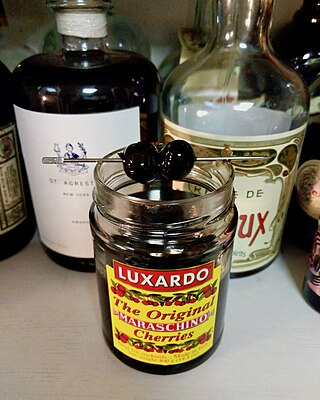
A maraschino cherry is a preserved, sweetened cherry, typically made from light-colored sweet cherries such as the Royal Ann, Rainier, or Gold varieties. In their modern form, the cherries are first preserved in a brine solution usually containing sulfur dioxide and calcium chloride to bleach the fruit, then soaked in a suspension of food coloring, sugar syrup, and other components.
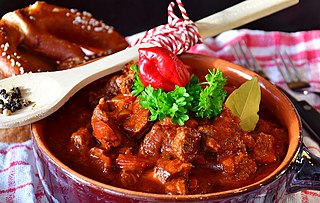
Hungarian or Magyar cuisine is the cuisine characteristic of the nation of Hungary, and its primary ethnic group, the Magyars. Hungarian cuisine has been described as being the spiciest cuisine in Europe. This can largely be attributed to the use of their piquant native spice, Hungarian paprika, in many of their dishes. A mild version of the spice, Hungarian sweet paprika, is commonly used as an alternative. Traditional Hungarian dishes are primarily based on meats, seasonal vegetables, fruits, bread, and dairy products.

A soufflé is a baked egg dish originating in France in the early 18th century. Combined with various other ingredients, it can be served as a savoury main dish or sweetened as a dessert. The word soufflé is the past participle of the French verb souffler, which means to blow, breathe, inflate or puff.
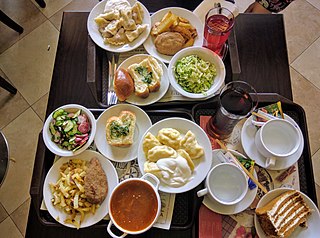
Ukrainian cuisine is the collection of the various cooking traditions of the people of Ukraine, one of the largest and most populous European countries. It is heavily influenced by the rich dark soil from which its ingredients come, and often involves many components. Traditional Ukrainian dishes often experience a complex heating process – "at first they are fried or boiled, and then stewed or baked. This is the most distinctive feature of Ukrainian cuisine".
Romanian cuisine is a diverse blend of different dishes from several traditions with which it has come into contact, but it also maintains its own character. It has been mainly influenced by Turkish but also a series of European cuisines in particular from the Balkan Peninsula and Hungarian cuisine as well as culinary elements stemming from the cuisines of Central Europe.

Comfort food is food that provides a nostalgic or sentimental value to someone and may be characterized by its high caloric nature associated with childhood or home cooking. The nostalgia may be specific to an individual or it may apply to a specific culture.
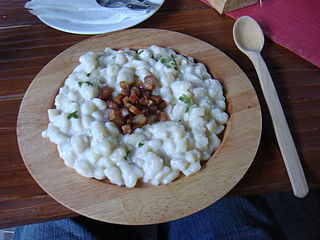
Slovak cuisine varies slightly from region to region across Slovakia. It was influenced by the traditional cuisine of its neighbours and it influenced them as well. The origins of traditional Slovak cuisine can be traced to times when the majority of the population lived self-sufficiently in villages, with very limited food imports and exports and with no modern means of food preservation or processing.

A banana split is an American ice cream-based dessert consisting of a peeled banana cut in half lengthwise, and served with ice-cream and sauce between the two pieces. There are many variations, but the classic banana split is made with three scoops of ice cream. A sauce or sauces are drizzled onto the ice cream, which is topped with whipped cream and maraschino cherries. Crushed nuts are optional.
The following outline is provided as an overview of and topical guide to chocolate:
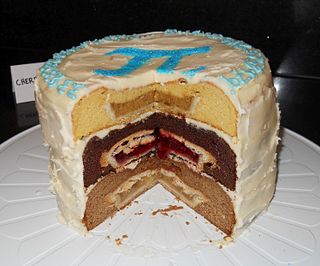
A cherpumple is a holiday novelty dessert inspired by Turducken, where several different flavor pies are baked inside of several different flavors of cake, and then stacked together. The combined dessert is coated in cream cheese frosting. According to the Cherpumple's creator, pop culture humorist Charles Phoenix, "Cherpumple is short for cherry, pumpkin and apple pie. The apple pie is baked in spice cake, the pumpkin in yellow and the cherry in white."
Pie in American cuisine has roots in English cuisine and has evolved over centuries to adapt to American cultural tastes and ingredients. The creation of flaky pie crust shortened with lard is credited to American innovation.